
Published: Last Updated:
Readtime: 20 min
Every product is carefully selected by our editors and experts. If you buy from a link, we may earn a commission. Learn more. For more information on how we test products, click here.
If you are looking for Sydney’s best steaks, my advice is to start with BISTECCA, Rockpool Bar & Grill, The Gidley, and Firedoor. Institutions for a reason, these meat-heavy venues deliver the best bone-in rib-eyes, dry-aged Wagyu, and flame-licked sirloins, backed by serious chef credentials and produce from farms like Cape Grim, Rangers Valley and David Blackmore. But don’t just stop there.
With Australia regularly producing A-grade quality beef, it’s no surprise that Sydney boasts some of the best steak restaurants in the world. Whether you want the fun of tableside carving (The Cut), the smoky finesse of wood fire (Woodcut, Firedoor), or old-school elegance with a killer wine list (The Gidley, Hubert), this list covers the best steak restaurants in Sydney right now, from high-end institutions to casual bang-for-buck grill houses.
Editors’ Picks: Sydney’s Best Steak Restaurants
Highlights from our list include the following options:
- The best steak restaurant in Sydney overall: BISTECCA
- For value-for-money: Chophouse Sydney
- For a large group: Woodcut
- For premium cuts: S’More
Now that we’ve looked at our favourites, let’s check out the complete list.
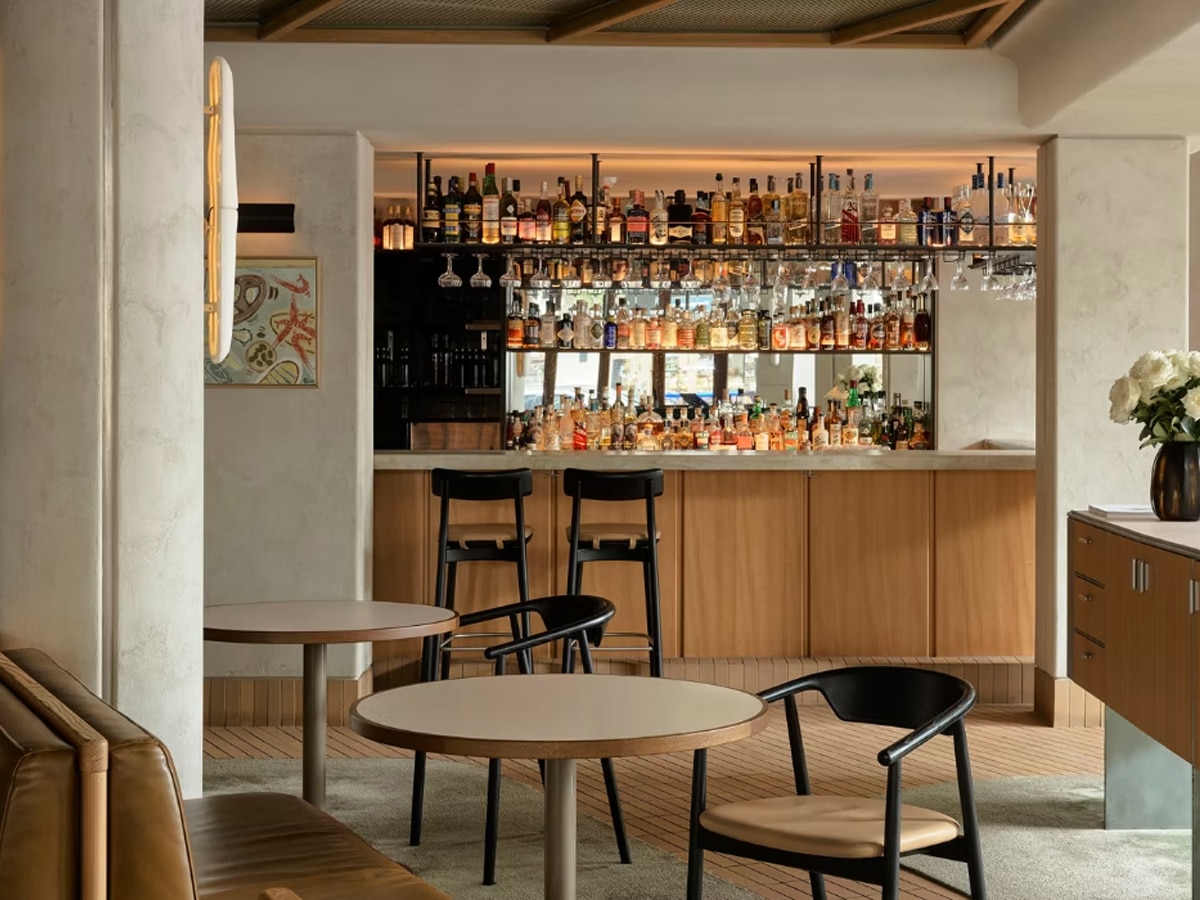
1. Margaret
Voted the second-best steakhouse in the world for 2025 and the best in Australia, Margaret is a pure example of wood-fired meat at its very best. Neil Perry’s neighbourhood institution, which is located in the ehart of Double Bay, celebrates premium Australian produce and the work of Australia’s most dedicated farmers and fishermen.
The restaurant uniquely balances seafood and steak, with Perry adding a slight Asian fusion influence to the menu. On the meat side, you’ll find Blackmore Wagyu, beef from retired Holstein-Friesian dairy cows, and a range of dry-aged offerings that are in high demand. Moving to sea, Margaret also serves up line-caught coral trout, Glacier 51 toothfish, Mooloolaba king prawns and Fraser Isle spanner crab, a nod to Perry’s Pan-Pacific focus. What’s more, Margaret is authentic in every facet of the business. Named after Perry’s late mother, the restaurant is designed to be more than just a dining destination.
What to order: David Blackmore Ration-Fed Full Blood Wagyu Rump
Steak price range: $70 average for main steaks
- Located in: Fortis
- Address: 30-36 Bay St, Double Bay NSW 2028
- Hours: Mon-Tues Closed, Wed 6–11 pm, Thurs-Sat 12–11 pm, Sun 12–10 pm
- Phone: (02) 9068 8888
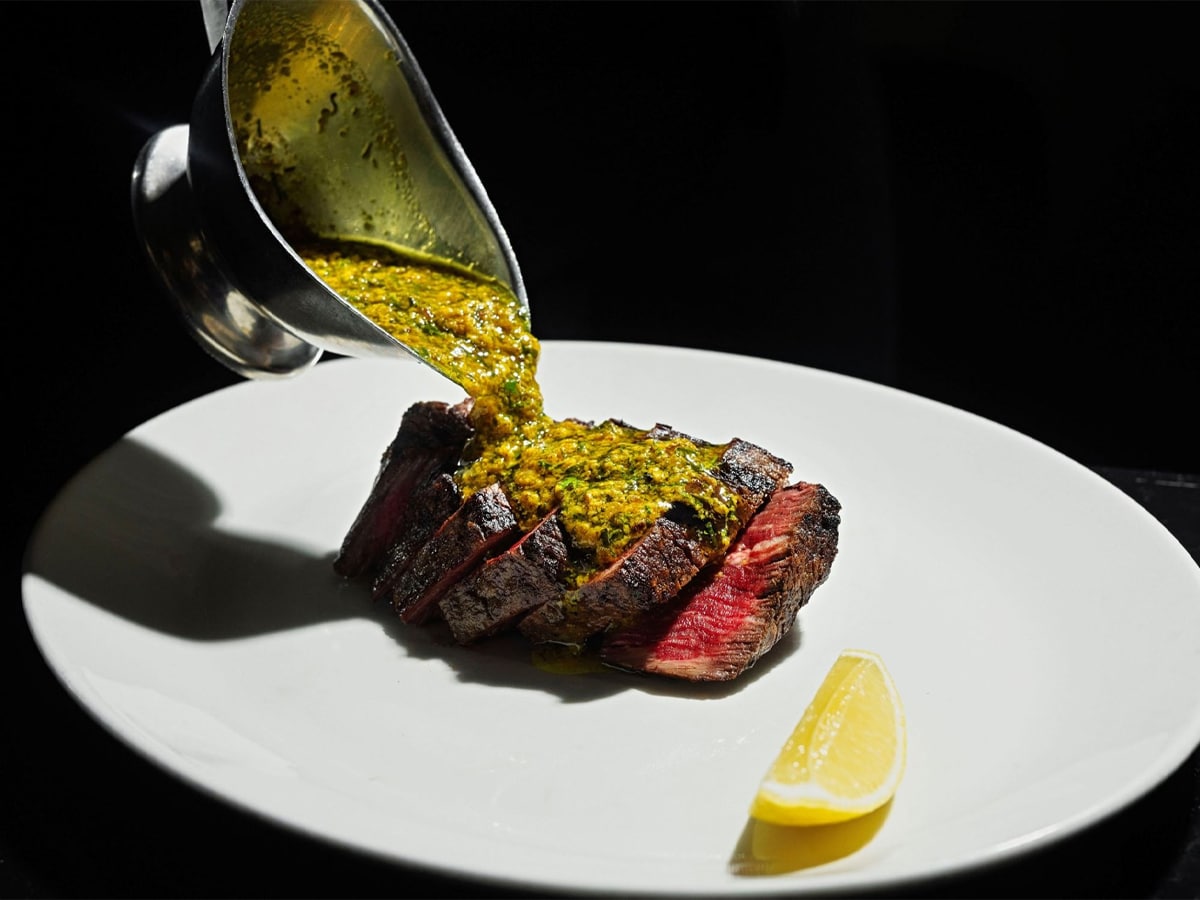
2. Rockpool Bar & Grill
As one of the premier dining establishments in Sydney, Rockpool Bar & Grill is a surefire winner for all foodies; however, if you are a fan of steak, this restaurant is a must-try. The iconic venue is best known for premium Australian beef, with specific cuts such as Rubia Gallega delivering one of the most refined steak experiences in Sydney.
Consistently ranked among the world’s best steak restaurants, Rockpool’s chefs butcher in-house daily and source from top producers like Cape Grim, Robbins Island and David Blackmore. If Rubia Gallega is on the menu, order it – it’s huge, intensely marbled, and unforgettable. Admittedly, this will be a pricey night out, so it’s best to save Rockpool for a special occasion, but if you get the opportunity to go, make sure you take it with both hands.
What to order: Rubia Gallega (if it’s on), Cape Grim rib-eye, or David Blackmore Wagyu sirloin
Steak price range: From $65 for a pasture-fed Scotch fillet up to $300+ for premium Wagyu and large-format cuts
- Address: 66 Hunter St, Sydney NSW 2000
- Hours: Mon – Fri 12–2:30 pm, 6–11:30 pm, Sat – Sun 12–2 pm, 5.30–11:30pm
- Phone: (02) 8099 707
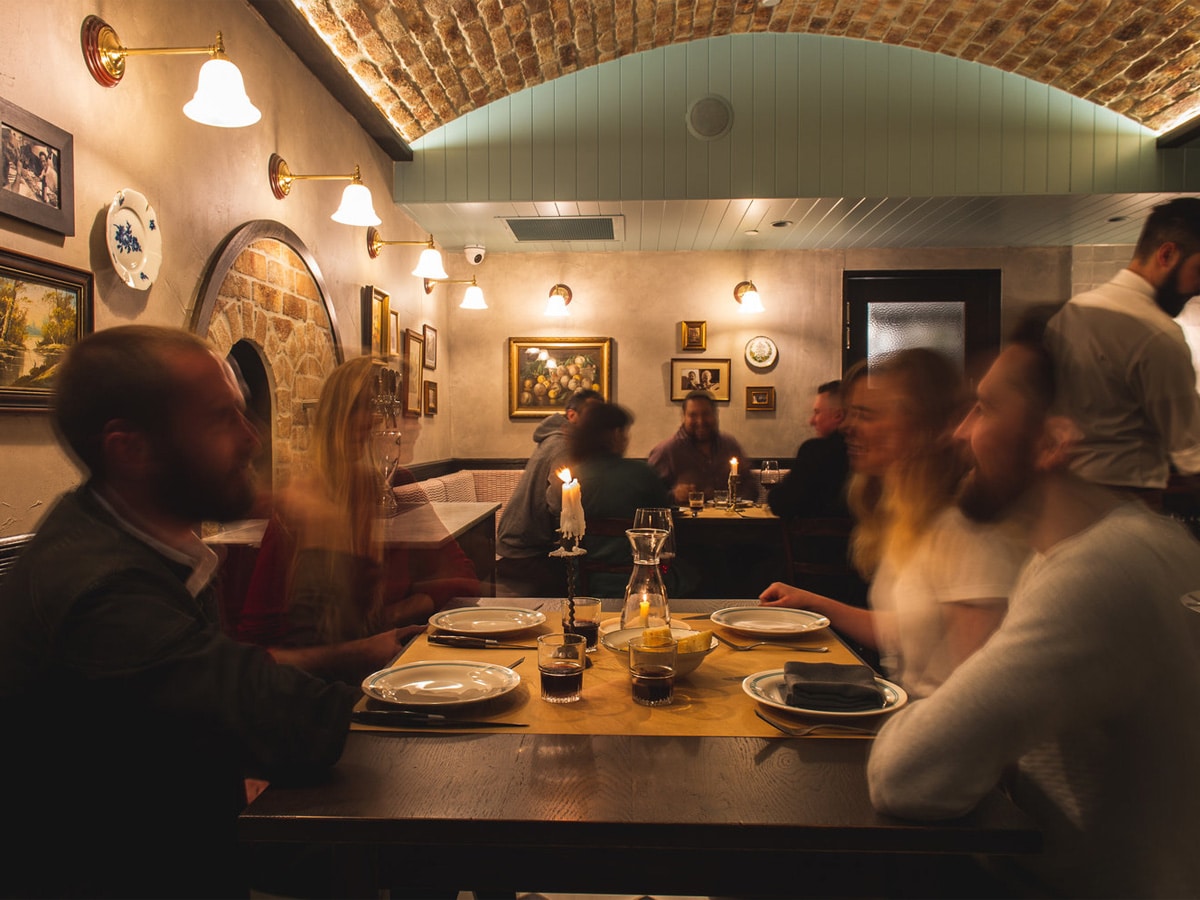
3. BISTECCA
Hidden behind an unmarked door and strictly phone-free, BISTECCA serves one steak and one steak only: T-bone, cut to order, charred over ironbark and olive wood, then sliced tableside. Add a few clever sides, a bold Italian red, and you’re in bistecca heaven.
At this fabled hotspot, you can expect a hearty experience with a healthy dose of Italian flair. The Sydney steak restaurant is revered for its take on the Tuscan-style Bistecca alla Fiorentina, offering meat-lovers a rare chance to indulge in one of the culinary industry’s best-loved creations. Cooked over fire and carved to share, the Bistecca special is the ultimate in social fine dining, providing a feast for both eyes and mouths.
Traditionally, then Florentine delicacy is made using the Chianina cow breed, but BISTECCA opts for a more local produce, sourcing black Angus beef from the Riverine region of NSW. Aside from that, BISTECCA offers a profoundly authentic experience, complete with marbled red meat that borders on blue, delicately swimmingly in a pool of olive oil and juice. This is a real meat-eater’s delight.
What to order: Bistecca alla Fiorentina (minimum 600g), woodfired grapes with ricotta, and roasted garlic pizza bread
Steak price range: $18 per 100g | Average serve ~600–800g ($108–$144+)
- Located in: Cliveden
- Address: 3 Dalley St, Sydney NSW 2000
- Hours: Mon-Sun 12pm-12am
- Phone: (02) 8067 0450
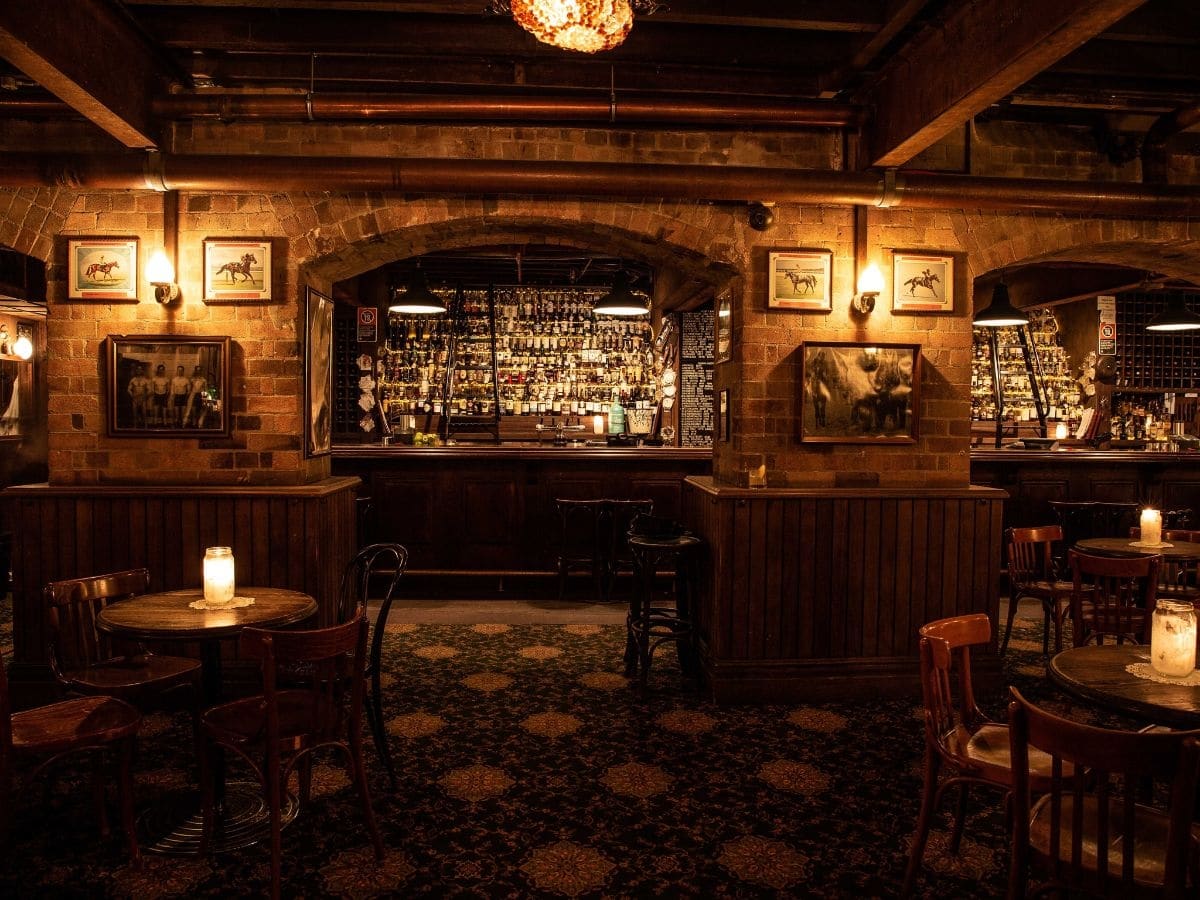
4. Restaurant Hubert
A slice of French provincial dining in the heart of the CBD, Restaurant Hubert is a mainstay on lists of Sydney’s best steak spots, and for good reason. At this classic eatery, you’ll find a range of premium cuts, served to your liking with heavy lashings of premium sides, sauces and decadent desserts. Ask anyone who has had the pleasure of dining at Restaurant Hubert and they’ll tell you what to expect: old-world charm, French classics, live jazz and some of the best steak in Sydney.
Unlike some of the other venues on this list, Restaurant Hubert isn’t merely a steakhouse. The dining destination also offers a range of French classics, from Bouef Bourguignon to escargot, and has a premium selection of bread and wine. If you love steak but your partner doesn’t, Restaurant Hubert has you covered. What’s more, the venue itself is stunning.
he dining room is all red velvet, soft lighting, and Champagne towers. topping Cote de Boeuf, which uses a 1KG Westholme wagyu rib eye cut that’s simply out of this world. You’ll find live jazz playing from Monday to Thursday, some of the best red wine in the city, and a nearly unmatched ambience.
What to order: Côte de Boeuf for two, Bouef Bourguignon, and a bottle of Burgundy
- Address: 15 Bligh St, Sydney NSW 2000
- Hours: Sun-Thurs 12pm-12am, Fri-Sat 12pm-12.30am
- Phone: (02) 9232 0881
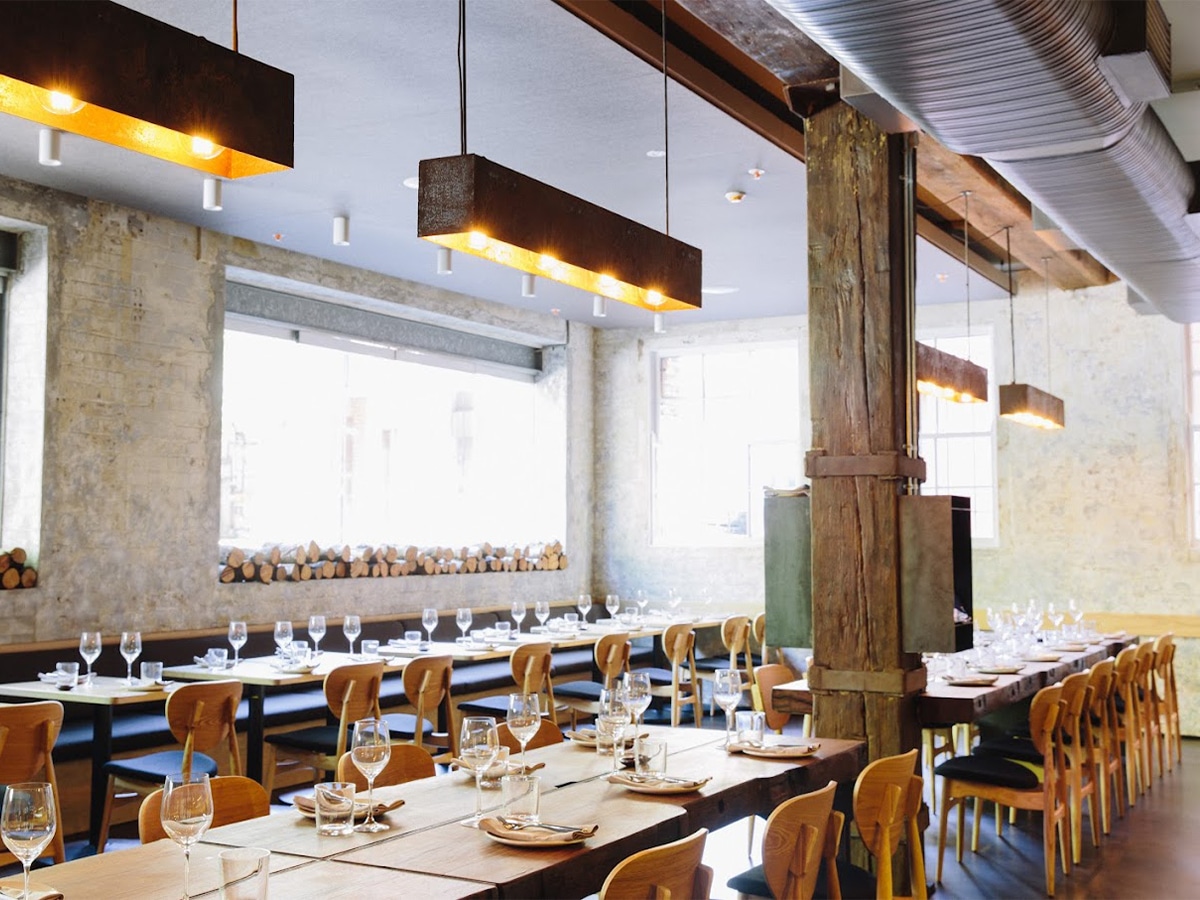
5. Firedoor Restaurant
When it comes to Sydney steak restaurants, there is no bigger name than Firedoor. The Surry Hills institution, helmed by influential Australian chef Lennox Hastie, has played a significant role in reestablishing the city’s culinary reputation and putting steak (quite literally) back on the menu. This insanely popular restaurant takes an artisanal approach to wood, using no less than a dozen different types to imbue every dish on the seasonal menu with singular, sensational flavour. At Firedoor, no two days are the same, so while you can expect to find live-fire cooking and rare ingredients, you should also keep an eye out for a menu that changes daily.
Far more than one of Sydney’s best steakhouses, Firedoor is equally adept in seafood or anything else Hastie gets his hands on for the day – try the Murray cod with charred cos, paperback, and pil-pil next to your choice of steak if it’s on the menu. Expect an unforgettable experience, assuming you can score a table in the first place, and we recommend booking well in advance. Bookings open on the first Wednesday of each month at midday.
What to order: Whatever steak is on the menu that night, plus anything with charred cos, pil-pil or smoked butter.
- Address: 23/33 Mary St, Surry Hills NSW 2010
- Hours: Wed-Thur 5-9pm, Fri-Sat 12-4pm & 5-9pm
- Phone: (02) 8204 0800
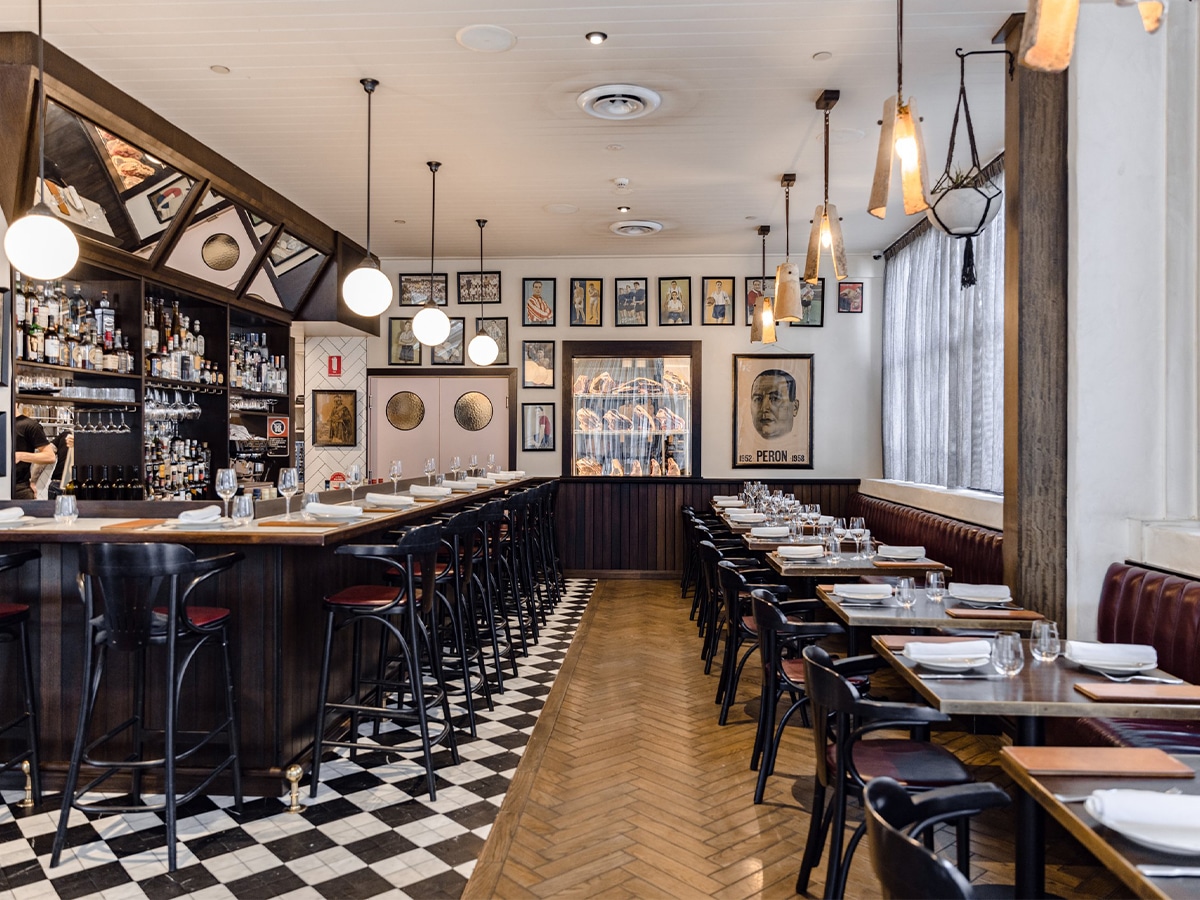
6. Porteño
With a menu that boasts flame-grilled meat, smoked chicken, and steak at an amazing price, it’s no wonder that Porteño is widely regarded as Sydney’s best steak restaurant. The sophisticated steakhouse fuses an Argentinian-inspired menu with in-house dry-aged steaks, delivering a truly unforgettable dining experience; just ask the critics.
Porteño has continuously been named among the world’s best steak restaurants, securing two hat certifications for a whopping 13 consecutive years. It is not just one of our favourite steak restaurants in Sydney, it’s among our favourite restaurants in the city full-stop. It has come to epitomise meat-centric dining with the feverish popularity to show for it. To call this a hotspot for great steaks is an understatement. With a $140pp Chef’s Selection Menu that could rival any in Sydney and includes Mayura Station Wagyu Carpaccio, Slow Smoked Charcoal Chicken, and an O’Connor Sirloin MB3+ that’s amongst the best value steak dinners on our list.
What to order: O’Connor sirloin, Mayura Wagyu carpaccio, charcoal chicken
What it’ll cost: À la carte from $50+ or Chef’s selection menu is $140 per person
- Address: 50 Holt St, Surry Hills NSW 2010
- Hours: Mon-Thur 5:45-11pm, Fri 12-2:30pm & 5:30-11pm, Sat 5:30-11pm, Sun 4:30-10pm
- Phone: (02) 8399 1440
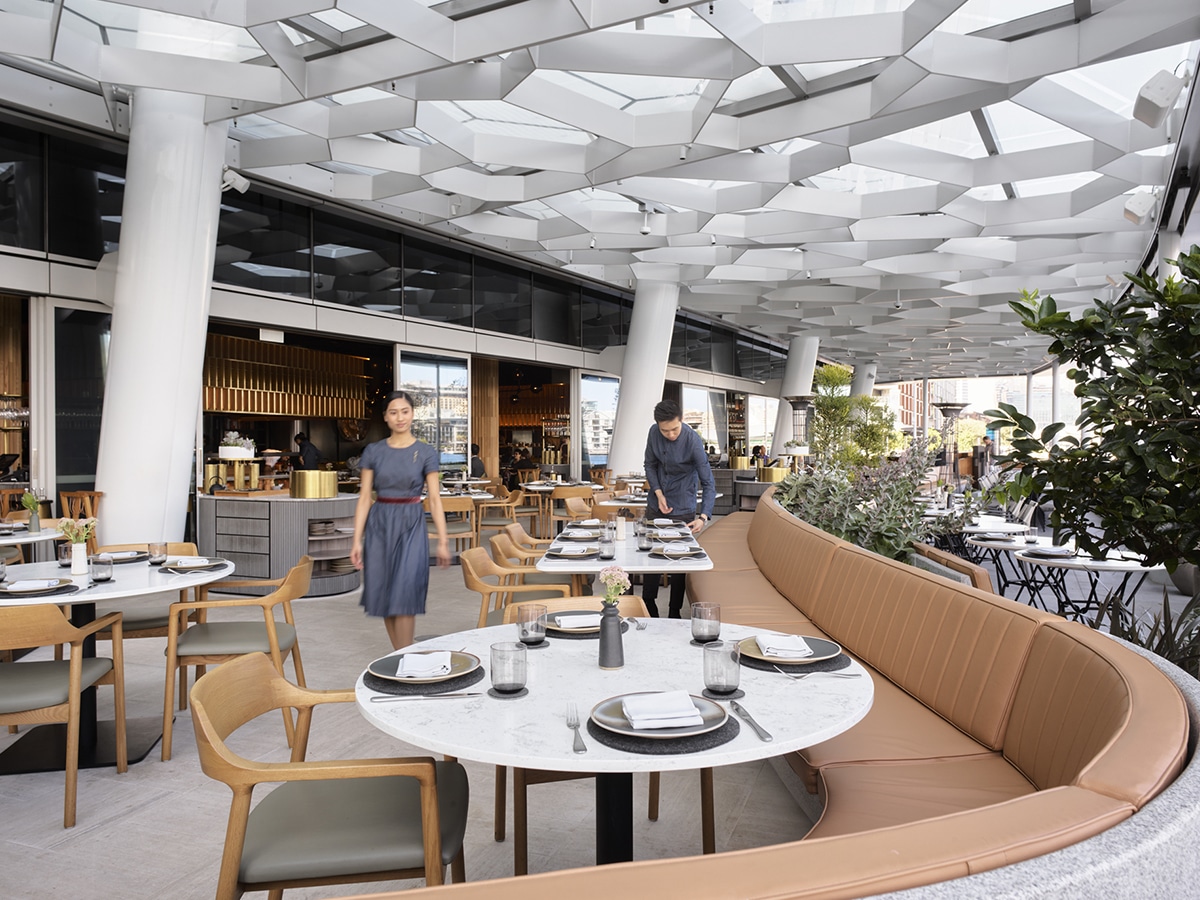
7. Woodcut
Located in the glamorous Crown Sydney hotel and casino in Barangaroo, Woodcut is unlike any steakhouse you’ve seen before. The sprawling 260-seat restaurant rejects the dark and dimly lit aesthetic we’ve come to expect for steak restaurants and instead exudes a bright and airy atmosphere, playing off its remarkable location and stunning vistas. The menu is just as surprising.
Expansive and intricate, the menu pays homage to slow-cooked meals in a wood-burning oven or over an open fire, and while the cuts change regularly, expect Tajima Wagyu, including a bone-in rib eye, MBS 6+ Wagyu 800g as the highlight of the menu. It’s so good you can taste the raw, earthy flavour of their wood-grilled steaks and wood oven bread, which pair perfectly well with an array of delicious sides and salads, like the Burrata with stone fruits, basil, basil seed dressing and the Wagyu beef skewer with rose harissa, spiced salt, pistachio, and mint.
If you ask us, you haven’t visited Sydney until you’ve had a steak at Woodcut in Barangaroo. This is one of our favourite spots to eat in Barangaroo because of its steak, so you can see why it cracks the list here. If you want to experience meat cooked the traditional way, this is the spot. Expect fire, steam, and plenty of smoke as the chefs perfectly cook your cut of choice in an open kitchen.
What to order: Tajima Wagyu, especially the 800g bone-in rib-eye (MBS 6+), if it’s on. Add the burrata with stone fruit or the Wagyu skewers with rose harissa (the sides are just as strong as the mains).
- Located in: Crown Sydney
- Address: Crown Sydney, Level 1/1 Barangaroo Ave, Barangaroo NSW 2000
- Hours: Mon 5:30-9:30pm, Tues-Sat 12-2:30pm & 5:30-9:30pm, Sun 12-2:30pm & 5:30-9pm
- Phone: (02) 8871 7171
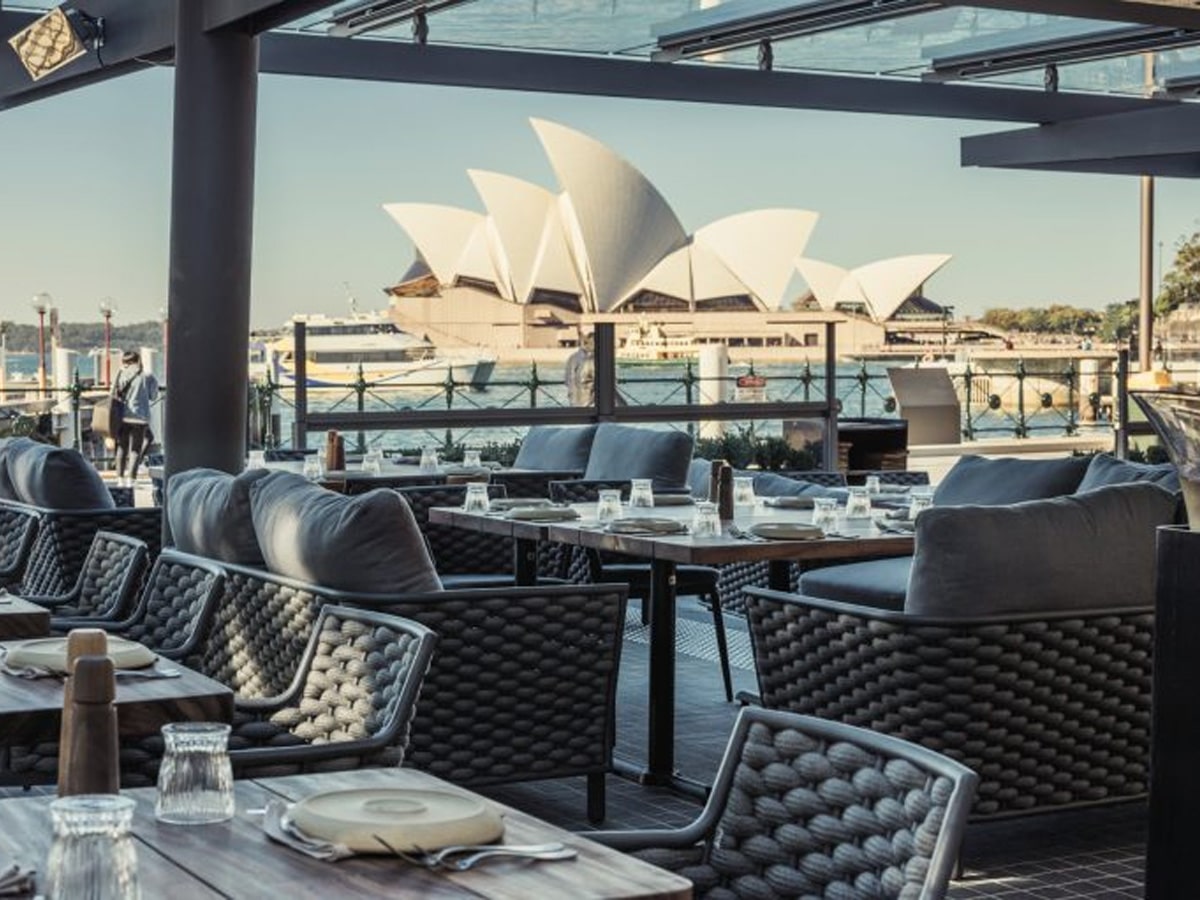
8. 6HEAD
What’s better than the ultimate steakhouse experience and views of Sydney’s iconic harbour? At 6HEAD, you can get just that. The waterfront steakhouse is led by award-winning Executive Chef Sean Hall, whose menu focuses on fresh, uncomplex dishes designed to allow the produce to speak for itself, featuring six cuts of steak: rump, rib-eye, T-bone, eye fillet, scotch fillet and sirloin. Some of our favourite dishes to pair with your steak include the kingfish ceviche and the chicken parfait, and, we recommend ordering the chimichurri sauce on the side — it’s truly life-changing. And, with a 250-strong wine list, you can rest assured it will be a good night.
What to order: Scotch fillet, sirloin with chimichurri, or the eye fillet with jus
- Located in: Campbell’s Stores
- Address: Bay 10 & 11, Campbell’s Stores, 7-27 Circular Quay W, The Rocks NSW 2000
- Hours: Mon 5-9:30pm, Tues-Thur 12-9:30pm, Fri-Sat 12-10:30pm, Sun 12-9pm
- Phone: (02) 8629 8866
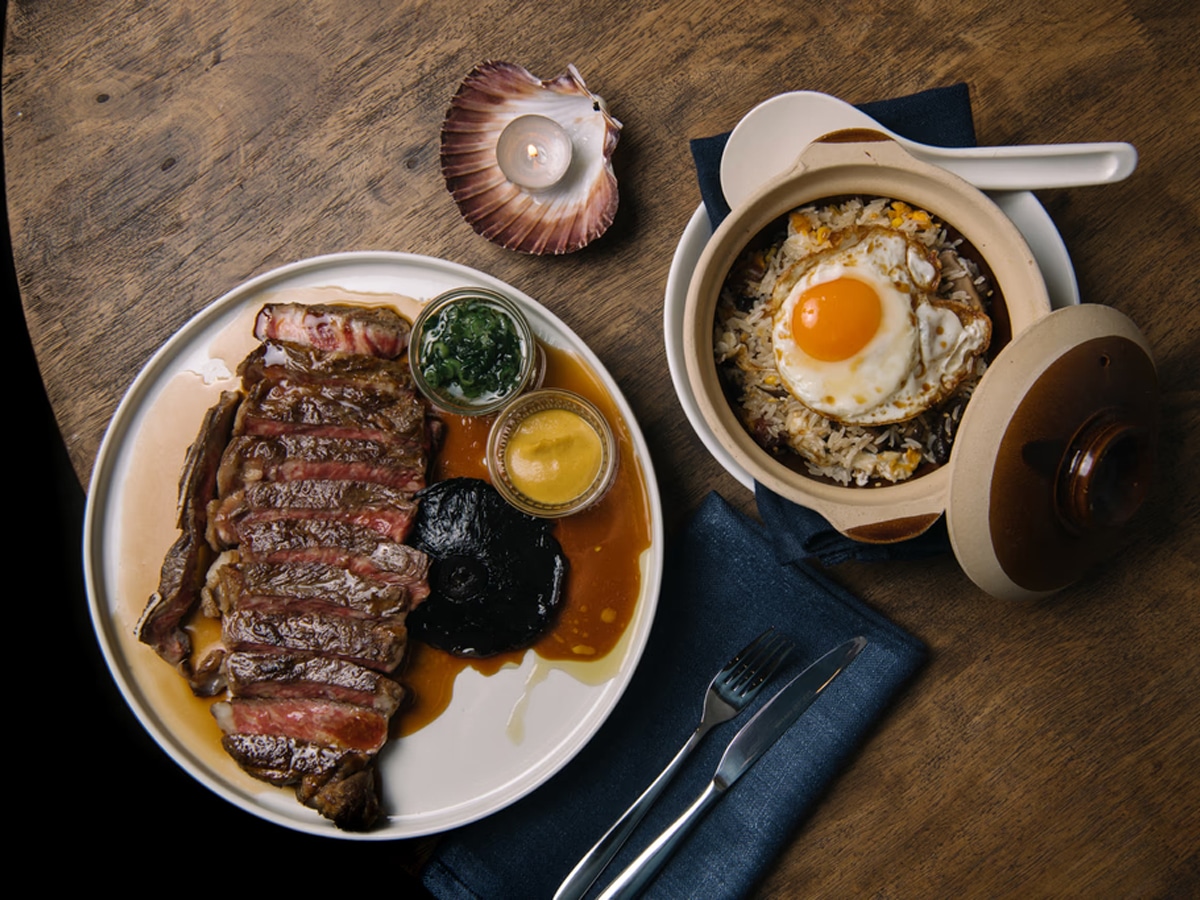
9. S’More
A step outside the steak restaurant Sydney is used to, S’More offers a relaxed and creative culinary experience. Led by celebrity chefs Big Sam Young and Grace Chen (aka Super Banana), the venue is positioned as a ‘neighbourhood bistro’, serving up high-quality, innovative food in a casual, relaxed setting.
S’More restaurant takes a unique approach, blending French-bistro classics with subtle Asian influences, and the result is that it is one of the best steak restaurants in Sydney. Of course, we’ve spent time devouring the famous lobster pasta, but the steak is just next-level. The menu rotates often, but look out for the full-blood 2GR Wagyu, allocation-only David Blackmore Rubia Gallega, and Ranger Valley MB 9+ boneless rib eye.
What to order: MB9+ boneless rib-eye, full-blood 2GR Wagyu, or Rubia Gallega if you’re lucky
- Address: 79 Edinburgh Rd, Castlecrag NSW 2068
- Hours: Tues-Fri From 5:30, Sat From 12pm
- Phone: 0482 075 072
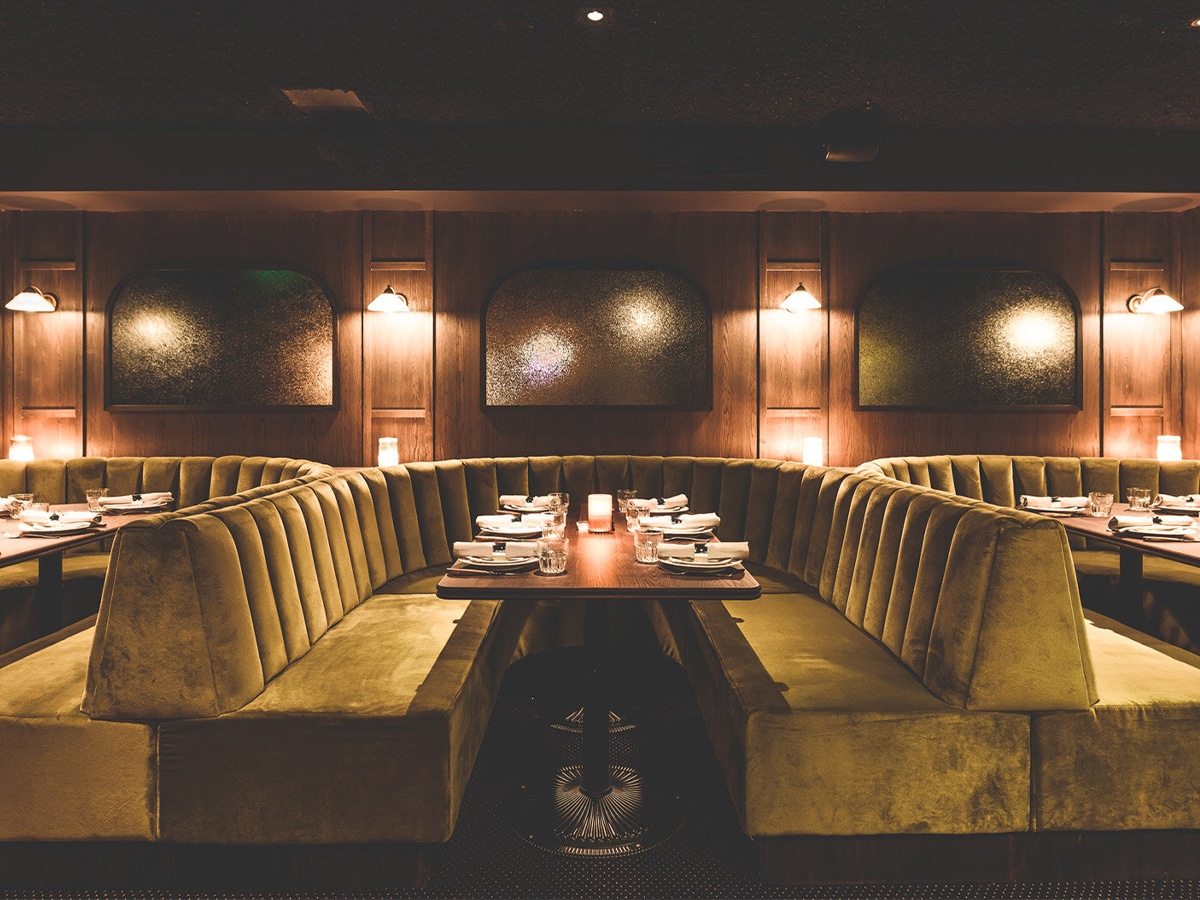
10. The Gidley
Hidden in a basement just off King Street, The Gidley is extra special from the moment you arrive. Brought to you by Liquid & Larder, the Sydney steak restaurant is the perfect combination of old-school atmosphere and new-world charm. Once you’ve made your way down dimly lit stairs, you are welcomed by a one-of-a-kind bar & lounge room where you can have a pre-dinner drink before heading into the beautifully furnished dining room.
Menu highlights include Australia’s exceptional Riverine Black Angus rib-eye, which can be ordered in three different ways: chargrilled rib-eye on the bone, prime rib roast (that can be served as a massive 700-gram cut or 300 grams of thinly sliced pieces) or as a spinalis steak (the most succulent cut when removed from the cap). In fact, The Gidley is one of the only restaurants in Australia that serves spinalis steaks. Finally, you can’t help but pick up one of their burgers while you’re there; it’s also rated as one of the world’s best.
What to order: Prime rib roast (300g or full slab), chargrilled rib-eye, or the spinalis steak if it’s on
- Address: Basement/161 King St, Sydney NSW 2000
- Hours: Mon-Sat 12pm-12am
- Phone: (02) 9169 6898
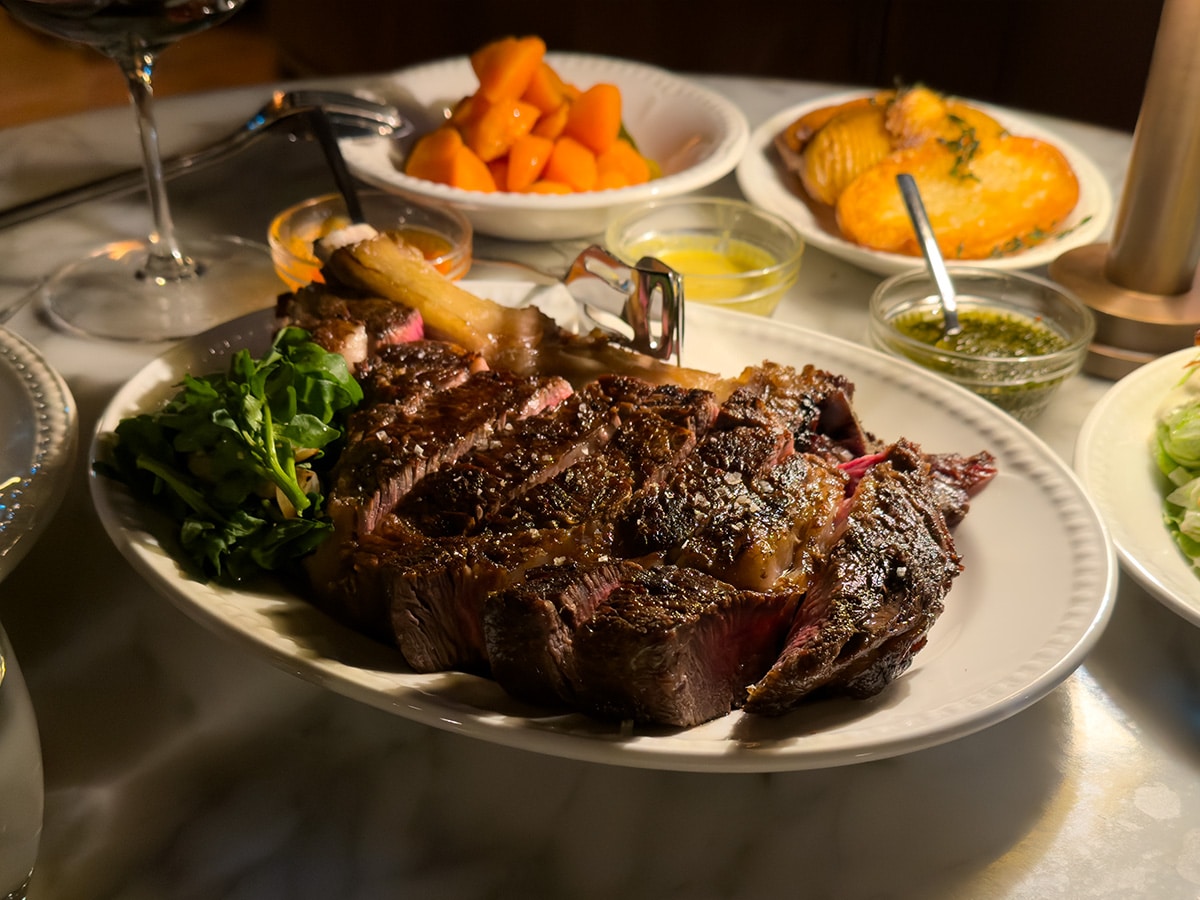
11. The Cut Bar & Grill
If you are looking for a big American-style steakhouse that offers cuts carved right at the table, The Cut Bar & Grill is for you. The brainchild of ex-Rockpool Bar & Grill Melbourne chef Johnny Murphy, alongside a trio of executive chefs that includes Santiago Aristizabal (Rockpool Bar & Grill), Shimpei Hatanaka (Sakeì Restaurant and Bar), and Andy Evans (Spice Temple), this Sydney steak spot has a little something for everyone.
The all-star cast has created a fairly priced, high-quality, New York Steakhouse-style restaurant that Sydneysiders won’t be able to get enough of. This place is perfect for date nights, birthdays, and team lunches. Cut Bar & Grill’s signature Pure Black Angus Prime Rib (300g and 450g) is cut table-side and is a must-have. However, the Altair Wagyu Grass-Fed Rib-Eye MBS 7+ 800g ($215) is where our hearts and eyes landed during our visit. Matched with a glass of Yalumba Shiraz and a side of twice-cooked potatoes in chicken fat, this is what steakhouse dreams are made of. Perfectly seasoned, cooked, and prepped, this is a must-visit Sydney steak restaurant.
What to order: Prime rib 300g or 450g, Altair Wagyu rib-eye (800g), and the chicken fat potatoes
- Address: 16 Argyle St, The Rocks NSW 2000
- Hours: Sun-Thur 12-9pm, Fri-Sat 12-10pm
- Phone: (02) 9259 5695
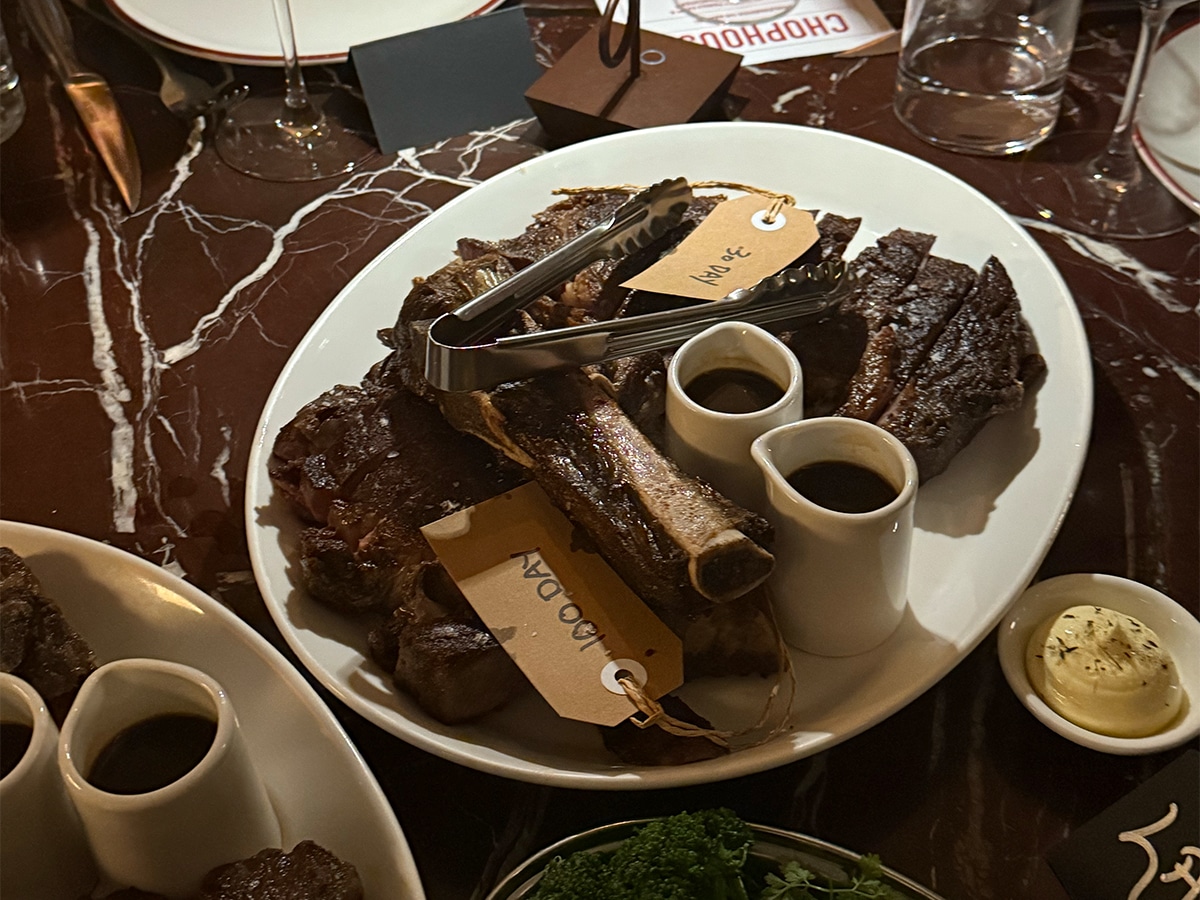
12. Chophouse Sydney
If you’re looking for the best dry-aged steaks in Sydney head to Matt Moran’s Chophouse restaurant. Conveniently located across the road from Rockpool (quite a bit more cost-effective and relaxed) this is a throwback, New York-style steakhouse that takes their meat and sides very seriously.
The Paris mash with burnt butter is a must-try alongside a cut of Rib on the bone (minimum 600g) that’s pasture-fed, Pinnacle, MB 2+, MSA graded, and available in 100g portions for around $20. While you’re there, grab one of the best burgers in Sydney, the Chophouse cheeseburger with bacon and caramelised onion jam for under $30. Pair it with a glass of South Australian Shiraz and you’ll be on to a winning recipe.
Unfettered in both name and principle, The Chophouse delivers succulent meat and chummy service in a modern setting. This top Sydney steakhouse goes by the appropriately direct slogan: “Fire. Meat. Wine”. We couldn’t put it better ourselves. The Chophouse is a crowd-favourite and is widely regarded as a worthy candidate for the best Sydney steakhouse title.
What to order: Rib on the bone (MB2+), 100-day aged striploin, and Paris mash with burnt butter
What it’ll cost: Steaks from around $55, dry-aged and large cuts from $90+
- Address: 25 Bligh St, Sydney NSW 2000
- Hours: Mon-Wed 12-9pm, Thurs-Fri 12-9:30pm, Sat 5:30-9:30pm
- Phone: (02) 9231 5516
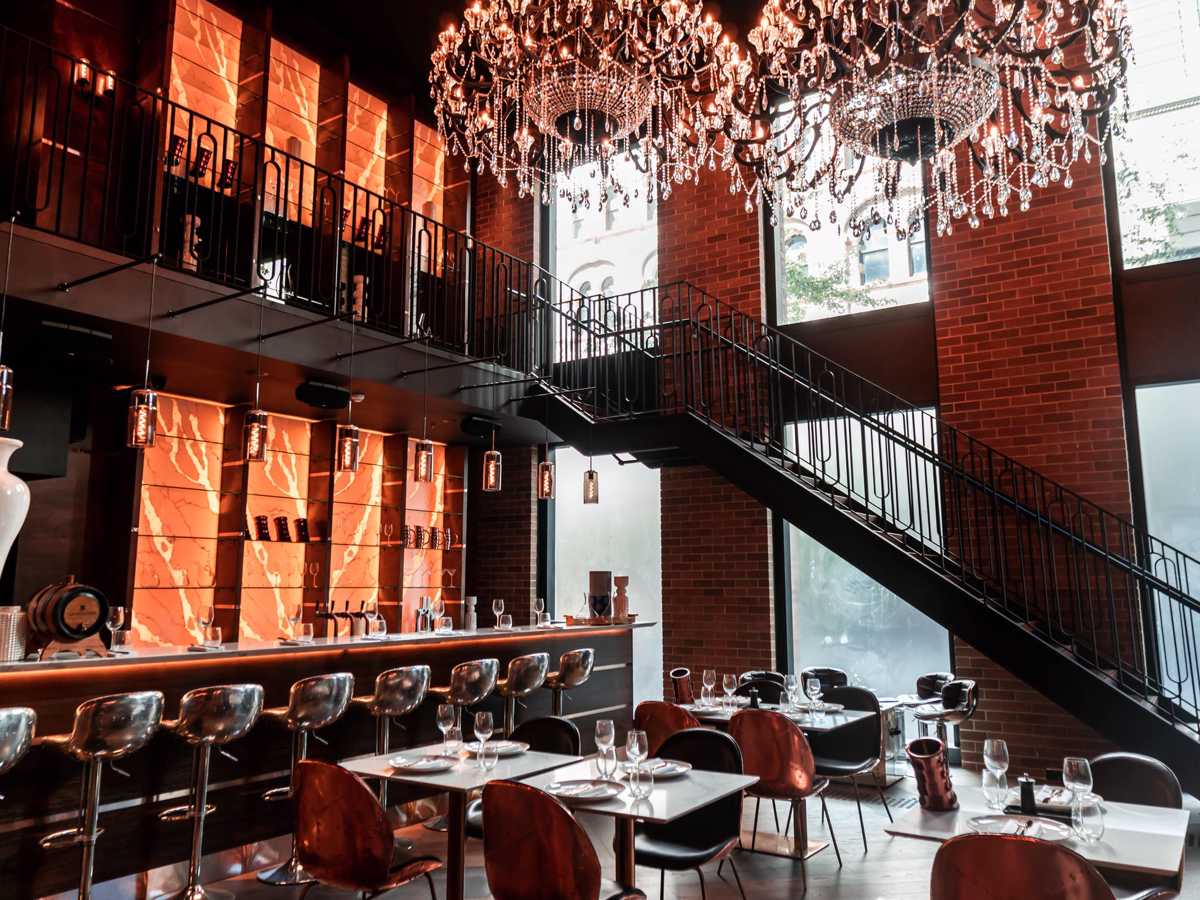
13. Firegrill Sydney
With sleek interiors, solid cuts and a big menu that works for groups, Firegrill Sydney is a one-stop meat lovers’ dream. The experience on offer isn’t short of amazing, the restaurant offers destination dining with an emphasis on classic timeless comfort and quality. The backbone of every great restaurant is a great restaurateur, and the Fire Grill offerings are curated by restaurateur Dah Lee. He offers a handpicked experience in an atmosphere that is luxurious yet fun. Take one step in the front door and you’re greeted with a beautiful kitchen, the smell of meat and décor that incorporates dark timbers, quartz, leather and many three-metre tall chandeliers.
What to order: Our favourite menu items include the lamb cutlets with onion purée and spring vegetables to start, the Hokkaido A5 wagyu sirloin, and the chargrilled tuna green beans in tarragon butter and tomato concasse.
- Address: 151 Clarence St, Sydney NSW 2000
- Hours: Tues-Fri 12–3 pm & 5:30–11 pm, Sat 5:30–11 pm
- Phone: (02) 9169 7870
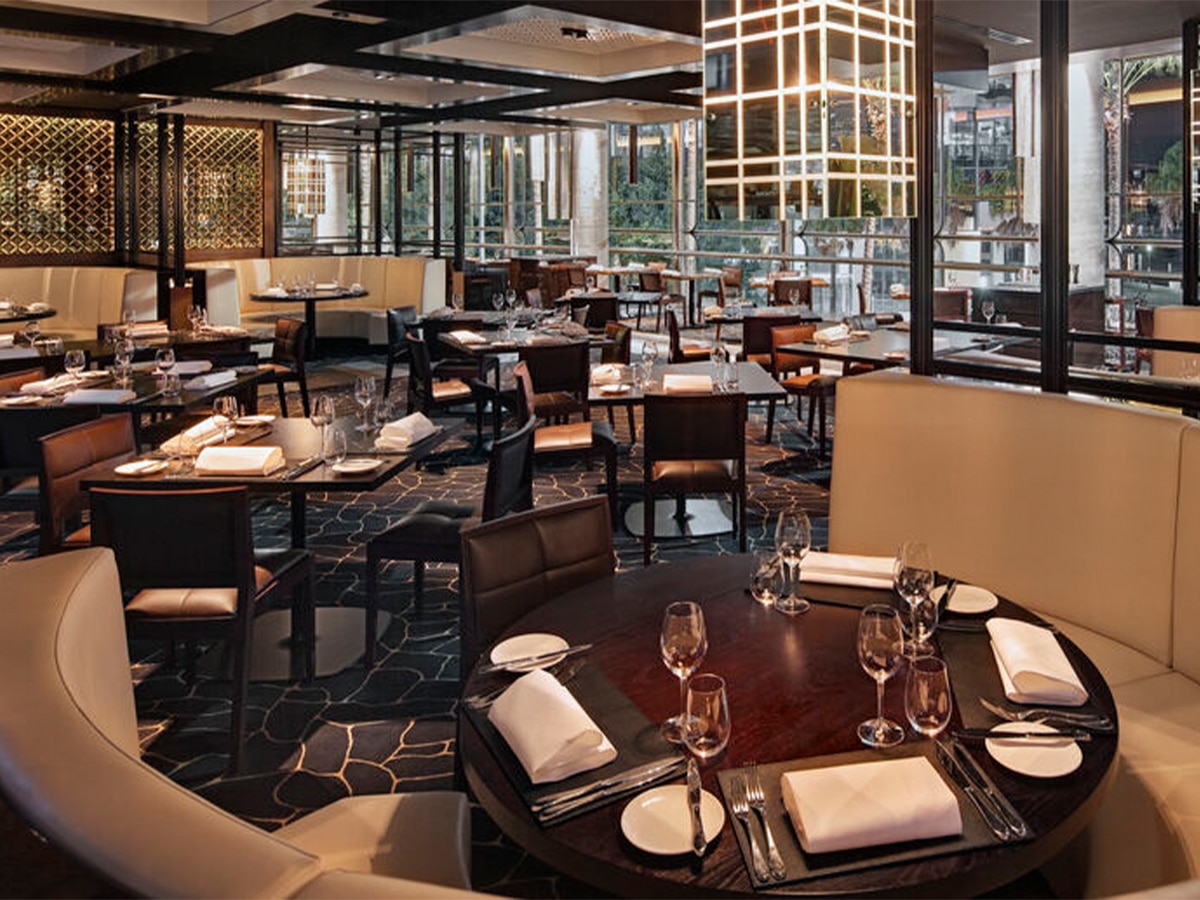
14. BLACK Bar & Grill
A classic steakhouse specialising in wood-fired steaks and seafood, you can taste the passion that goes into every meal at BLACK Bar & Grill. The beef here is lightly smoked to infuse the sweet delicate flavour of cherry wood ash before being grilled over high-heat Australian iron bark on the wood-fired grill, the slow-burning wood and combustion resulting in some of the most flavourful steaks you will ever enjoy. We recommend ordering from the grill section of the menu, with standouts including the Wagyu tasting chef’s selection and the ribeye 40-day dry-aged grass-fed Angus MBS3+.
What to order: Dry-aged Angus rib-eye, Wagyu tasting selection, wood-grilled seafood
- Located in: The Star Sydney
- Address: Harbourside, The Star, Level G/80 Pyrmont St, Pyrmont NSW 2009
- Hours: Wed-Thurs 5-10pm, Fri-Sun 12-3pm & 5-10pm
- Phone: 1800 700 700
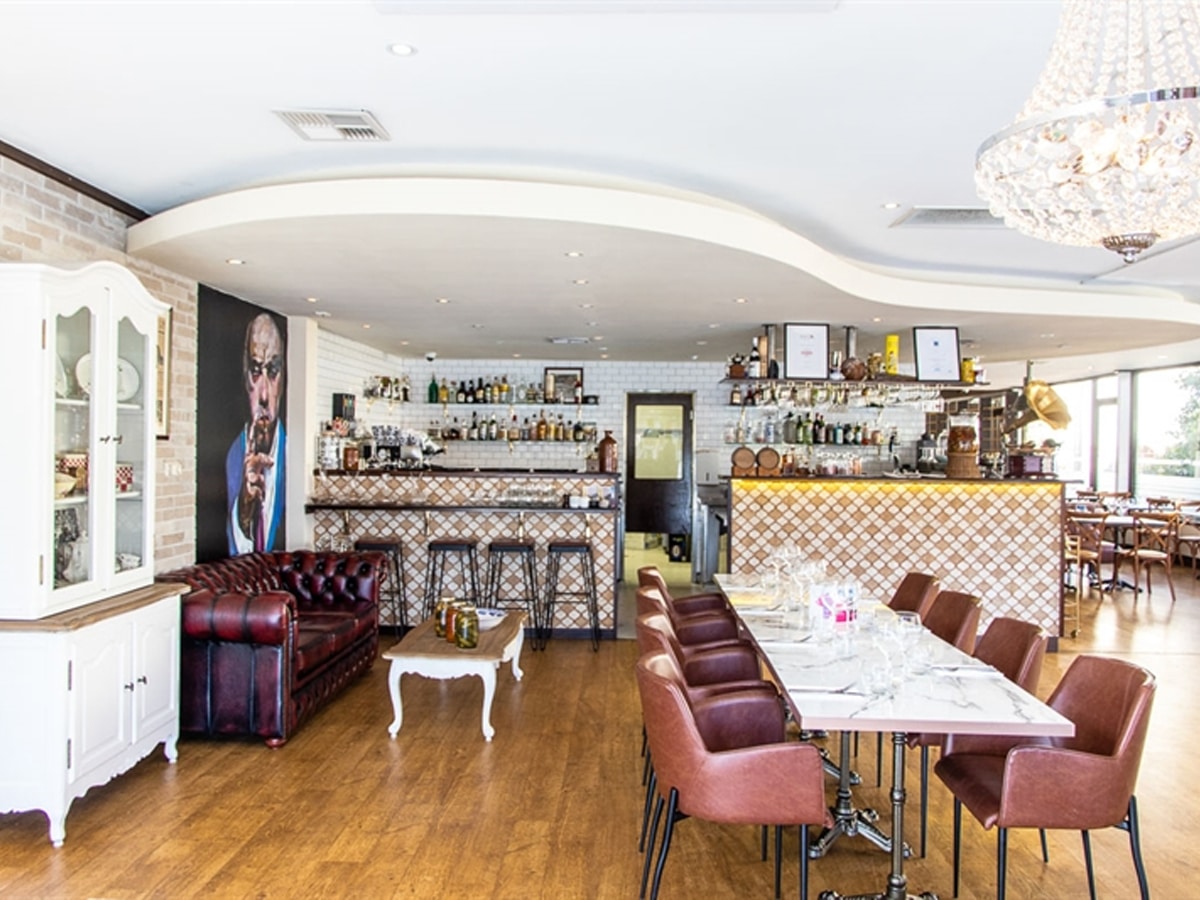
15. Brasserie L’Entrecôte
With two locations in Sydney, one in the CBD and one on the upper north shore, Brasserie L’Entrecôte is a much-loved, french-inspired steakhouse. Taking a nod from the original Le Relais de l’Entrecôte, the famous one-dish steakhouse that opened in 1959 in Porte Maillot, Paris, you can expect a similar ethos here. They like to keep things simple, serving up quality sirloin steak with a delicious secret sauce, crispy homemade French fries, a fresh salad and a glass of wine. Along with their signature charcoal-grilled sirloin, make sure to try the Les Escargots, too.
What to order: The signature sirloin and sauce combo, escargots to start, crème brûlée to finish
- Address: 1047 Pacific Hwy, Pymble NSW 2073
- Hours: Tues-Thur 5:30-9pm, Fri-Sun 11:30am-2pm & 5:30-9pm
- Phone: (02) 8021 2433
Best Steak Restaurants in Sydney Honourable Mentions
- Steersons Steakhouse, Sydney: Panoramic views aren’t the only draw here, with steaks so good you won’t know what’s hit you. We recommend the Havericks dry-aged beef, served with either roasted Australian tiger prawns with béarnaise sauce or grilled petite lobster tail with garlic butter. We can’t go past the roasted bone marrow with parmesan crust and the heirloom tomato salad for something on the side.
- Kingsleys Australian Steakhouse, Sydney: Kingsleys in the CBD is a wildly popular spot strewn between two levels inside what was once a candle factory. It’s a wildly popular spot for one reason: They cook a downright incredible steak. We can’t go past their grassland premium beef steak, particularly the rib-eye surf & turf with prawns. The mains also fare just as well—the confit Aylesbury duck leg with glazed beetroot, eschalots, cherries, and port deserves a special mention.
Why Trust Us
We’ve eaten our way through plenty of sirloins, rib-eyes and tomahawks to put this list together. Some of these restaurants we’ve visited ourselves. Others come backed by consistent reviews, expert chefs, and reputations that speak for themselves. We looked at steak quality first – where it’s from, how it’s cooked, and how well it’s served. From dry-aged to Wagyu, we gave extra credit to venues using standout producers like Cape Grim, Rangers Valley, and David Blackmore. We also factored in value for money, sides, wine lists, and service, because a good steak is only part of the picture. You can check out our editorial policy and guidelines for more information on how we put together our ‘best of’ lists.
More Sydney Food & Drink Guides
Looking for more spots to try? Check out our other roundups below, whether you’re chasing the best burgers, cocktails or late-night feeds, we’ve done the groundwork.
- Best Places for Dessert in Sydney
- Best Beer Gardens in Sydney
- Best Steak Restaurants in Sydney
- Best Bars in Sydney for a Fun-Themed Night Out
- Best Rooftop Bars in Sydney
- Best Bottomless Brunches in Sydney
- Best Hidden Bars in Sydney
- Best Cafes in Sydney
- Best Live Music Venues in Sydney
Best Sydney Steak Restaurants FAQs
All three are popular cuts, but they cook and eat a little differently. Rib-eye and scotch fillet come from the same part of the cow (the rib), but rib-eye usually includes the bone and a bit more marbling. Scotch fillet is boneless and still rich, but slightly leaner. Sirloin is a bit firmer and less fatty, but still full of flavour (it’s the classic “steak and chips” choice).
If you like rich, buttery, melt-in-your-mouth steak, Wagyu is hard to beat. The fat content is higher, which means more flavour and tenderness, especially at MB6+ and above. That said, not everyone prefers it. Some people find it too soft or fatty. If you like a bit more bite and char, a good Angus rib-eye might be more your style (and easier on the wallet).
It depends how hungry you are and whether you’re sharing. A 300–400g cut is standard for one person. Once you’re hitting 600g or more, it’s usually made to share. Some venues serve 1kg+ cuts carved tableside, which is a great option if you’re with a mate and want to make a night of it.
Yes, if you can find one. The spinalis is the cap that runs along the outside of the rib-eye and it’s packed with flavour. It’s tender, marbled, and often considered the best bite of the whole steak. Most places don’t serve it on its own, but The Gidley does. If it’s on the menu, it’s worth trying at least once.


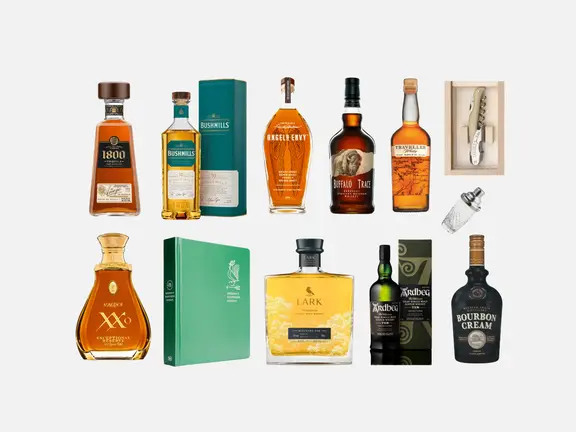



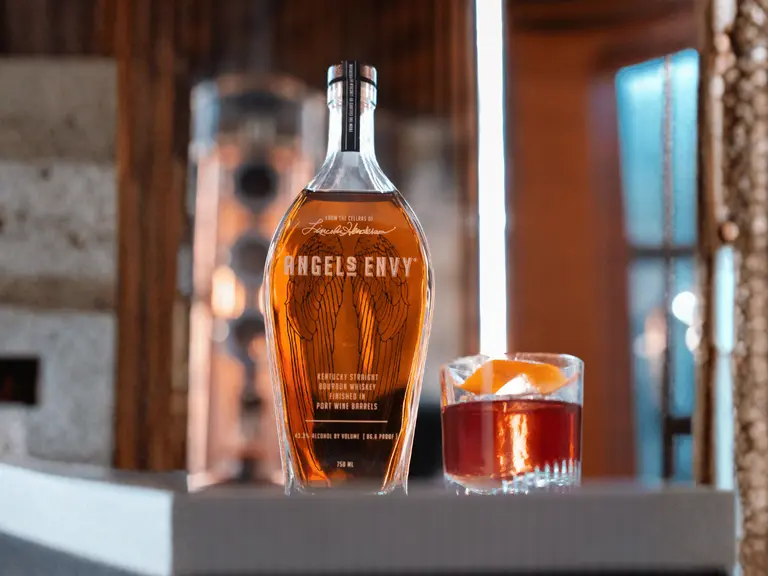







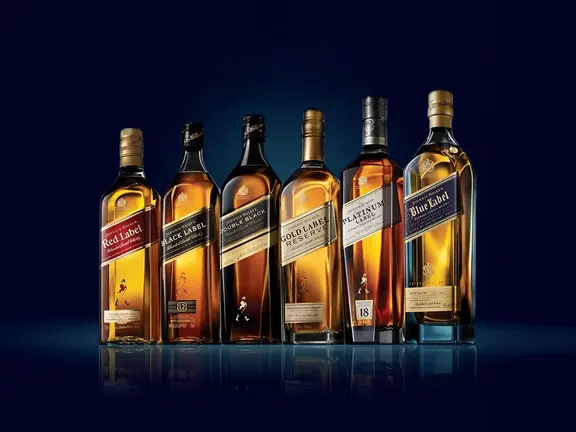
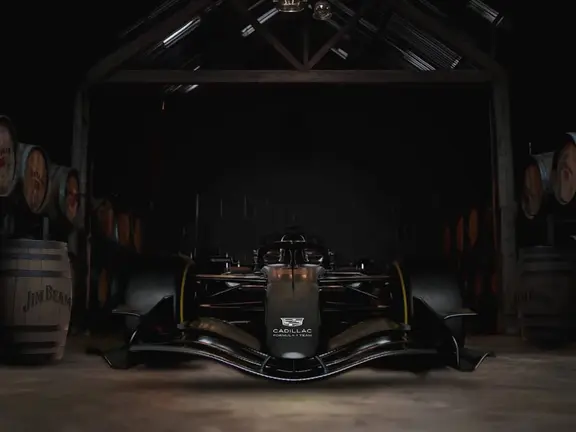





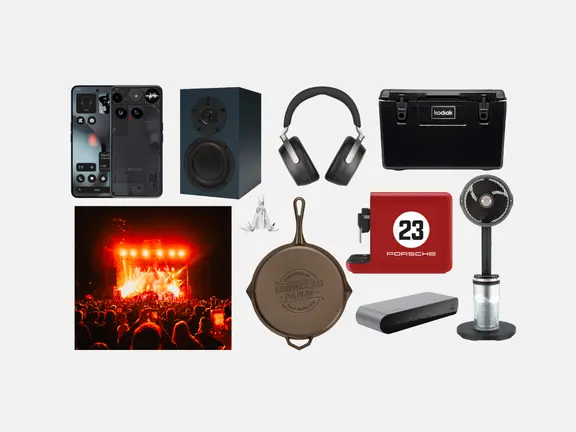


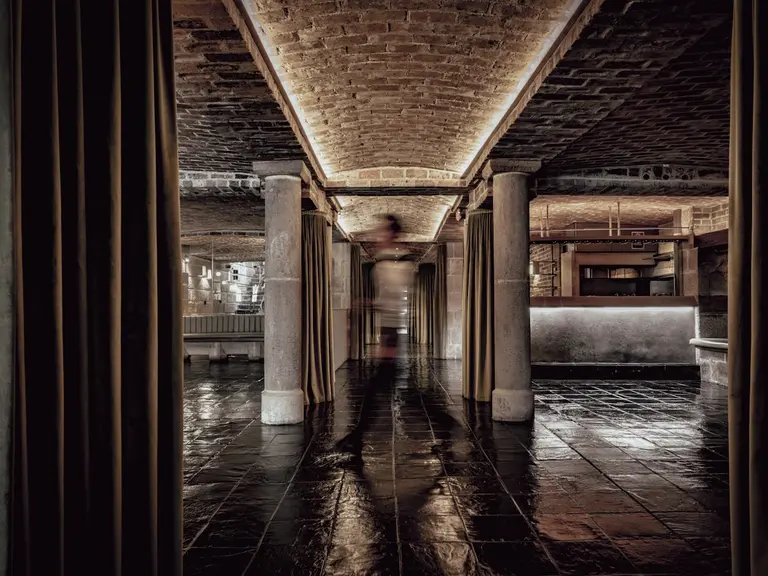
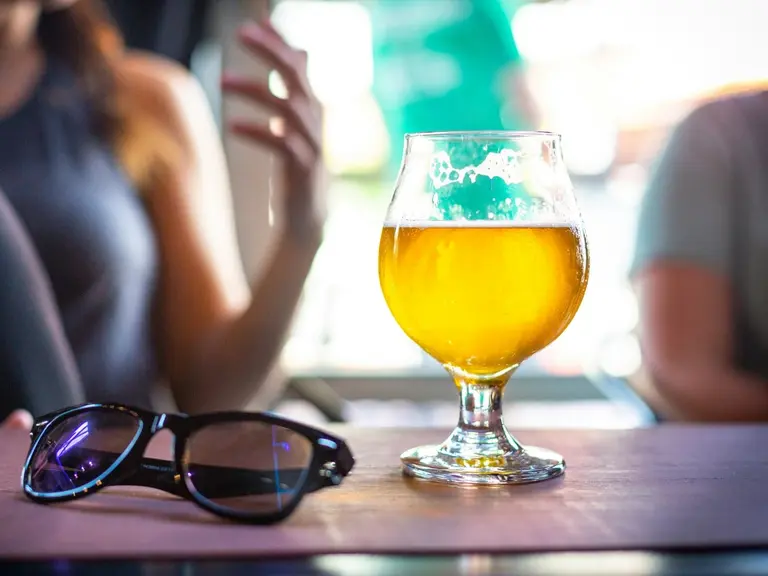


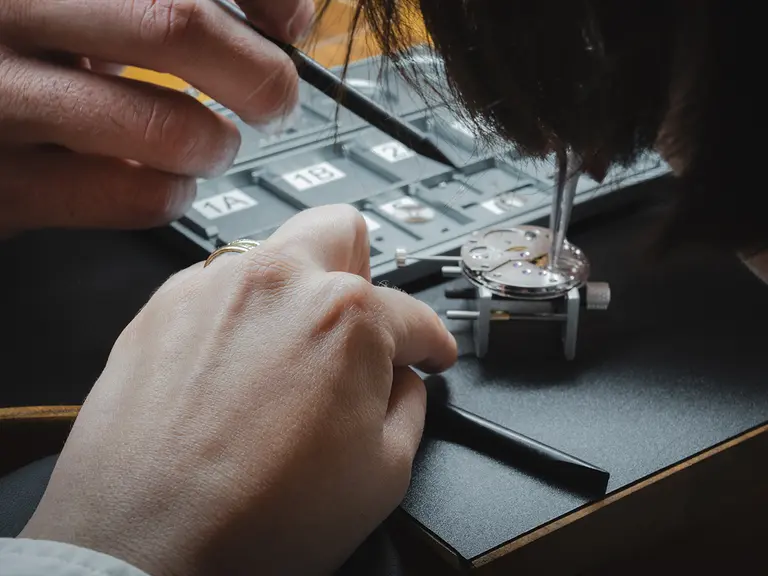


Comments
We love hearing from you. or to leave a comment.